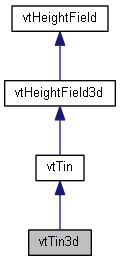|
vtlib library
|

Public Member Functions | |
| bool | Read (const char *fname, bool progress_callback(int)=NULL) |
| void | SetColorMap (ColorMap *color_map) |
| virtual bool | FindAltitudeAtPoint (const FPoint3 &p3, float &fAltitude, bool bTrue=false, int iCultureFlags=0, FPoint3 *vNormal=NULL) const |
| void | MakeMaterialsFromOptions (const vtTagArray &options, bool bTextureCompression) |
| void | MakeMaterials (ColorMap *cmap, osg::Image *image, float fScale, float fOpacity, bool bTextureCompression) |
This class extends vtTin with the ability to call vtlib to create 3d geometry for the TIN. It also subclasses vtHeightField so it provides the ability to do height-testing and ray-picking.
There are three ways to apply materials to the surface.
|
virtual |
Returns true if the point was over the TIN, false otherwise.
Reimplemented from vtTin.
| void vtTin3d::MakeMaterials | ( | ColorMap * | cmap, |
| osg::Image * | image, | ||
| float | fScale, | ||
| float | fOpacity, | ||
| bool | bTextureCompression | ||
| ) |
Lower-level method to make materials.
| void vtTin3d::MakeMaterialsFromOptions | ( | const vtTagArray & | options, |
| bool | bTextureCompression | ||
| ) |
High-level method to make materials from layer options.
| bool vtTin3d::Read | ( | const char * | fname, |
| bool | progress_callbackint = NULL |
||
| ) |
Read the TIN from a file. This can either be an old-style or new-style .tin format (so far, a VTP-specific format)
|
inline |
Takes ownership of the colormap you provide
 1.8.10
1.8.10